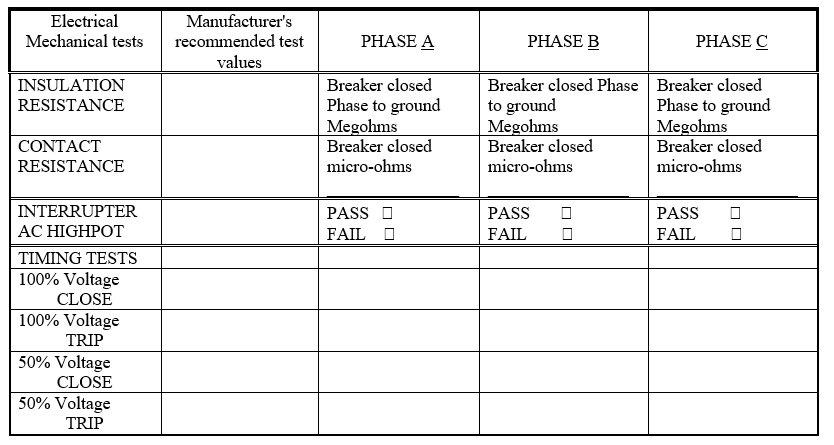ELECTRICAL TESTS HV POWER CIRCUIT BREAKERS
VISUAL INSPECTION OF HV POWER CIRCUIT BREAKERS
- Inspect for physical damage and nameplate compliance with single line diagram.
- Inspect the breaker for defects or damage especially to inter phase insulation.
- Inspect primary bushings and insulators for cracks and damage.
- Inspect primary disconnects, finger clusters etc. for damage and proper installation.
- Check contact wear indicator on vacuum circuit breakers.
- Check contact wear indicator on vacuum circuit breakers.
- Check mounting frame, all castings, and vacuum bottles for cracks.
- Check MOC and TOC switches in the cell if so equipped.
- Check that the mechanism is properly lubricated and parts are corrosion free.
MECHANICAL INSPECTION/TESTS
- Check flexible bus connectors and all brazed or soldered connections.
- Check the operating mechanism for friction.
- Check the push rods, and the latching mechanism.
- Check the trip mechanism, latch load, and sneak settings if applicable.
- Check manual close, latch and trip operation.
- Check trip free operation.
- Check auxiliary switches for proper operating sequence, contact alignment, and proper adjustment of the operating linkage.
- Check terminal blocks and connections.
- Check the mechanical condition of auxiliary devices, shock absorbers, bumpers, position indicators, latch checking switches , key lock out, etc.
- Check alignment of secondary contacts of circuit breaker to cell.
- Verify correct operation of the shutter mechanism.
- Verify primary contacts are properly aligned and lubricated.
- Check lock out mechanism operation of circuit breaker when installed in the cell.
- Rack breaker into the cell checking for proper operation in the test, transient, and connected positions. Verify the circuit breaker is trip-free through the transient position. Verify that the circuit breaker moves in and out of position with ease.
- Measure and record moving contact travel. (wear indicator).
- Check and record opening and closing speed (timing) of the circuit breaker.
- Verify that all circuit breakers of the same rating are interchangeable by racking each circuit breaker into each cell of the designated size.
ELECTRICAL TESTS OF HV POWER CIRCUIT BREAKERS
- Measure and record contact resistance of each pole with the test probes connected to the main current carrying bus, at the back of the breaker. Do not connect to the disconnecting stabs or finger clusters for measurements. Values must be consistent with manufacturer’s recommendations.
- Perform an insulation resistance test with a 1000 megger for one (1) minute from pole to pole and from each pole to ground and across open contacts of each phase.
- Check for vacuum integrity by testing with high potential AC from line to load with the breaker in the open position. The voltage rating of the interrupter shall determine the test voltage. The minimum test voltage for 5 KV interrupters is 14.3 KV AC and 27 KV AC for interrupters above 5 kV, up to and including 15 KV.
- Perform AC high potential tests line to load, phase-to-phase, line to ground and load to ground.
- Test the insulation resistance of the circuit breaker control wiring per recommended values in P-000.
- Close and open the breaker using the control switch, trip the breaker from each protective relay and trip device.
- Auxiliary protective devices, such as ground fault or under voltage relays, shall be activated to insure operation of shunt trip devices.
High Potential Test

